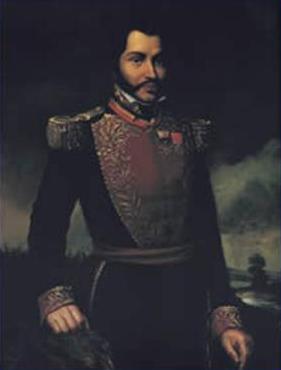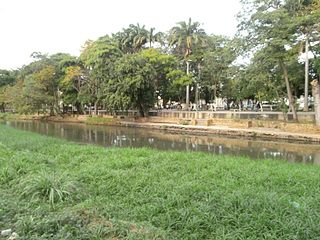
Antonio José de Sucre y Alcalá, known as the "Gran Mariscal de Ayacucho", was a Venezuelan general and politician who served as the president of Bolivia from 1825 to 1828. A close friend and associate of Simón Bolívar, he was one of the primary leaders of South America's struggle for independence from the Spanish Empire.

The Sucre State is one of the 23 states of Venezuela. The state capital is Cumaná city. Sucre State covers a total surface area of 11,800 km2 (4,600 sq mi) and, as of the 2011 census, had a population of 896,921. The most important river in the state is the Manzanares River.

Carúpano is a city in the eastern Venezuelan state of Sucre. It is located on the Venezuelan Caribbean coast at the opening of two valleys, some 120 km east of the capital of Sucre, Cumaná. This city is the shire town of the Bermúdez Municipality and, according to the 2010 Venezuelan census, the municipality has a population of 173,877 inhabitants. Carúpano is considered the gateway to the Paria Peninsula and its main commercial and financial center.

Municipalities of Venezuela are subdivisions of the States of Venezuela. There are 335 municipalities dividing the 23 states and the Capital District.

The Araya Peninsula is a peninsula on the Caribbean Sea, located in Sucre State, northern Venezuela.
Marigüitar is a small coastal town in the state of Sucre, Venezuela. It lies on the southern coast of the Gulf of Cariaco, across from the Araya Peninsula. The nearest city is Cumaná, about 20 kilometers to the east. The narrow, winding road that connects Cumaná and Carúpano passes through the town. Marigüitar has a large fish-processing plant owned by Mavesa, which is a subsidiary of Empresas Polar, the largest food and drink company in Venezuela. The fish processing plant serves as the principal source of employment for the town's residents. A small fleet of buses, pick-up trucks, and privately owned cars provide transportation from the town to the surrounding communities and to Cumaná.

The Cariaco Basin lies off the north central coast of Venezuela and forms the Gulf of Cariaco. It is bounded on the east by Margarita Island, Cubagua Island, and the Araya Peninsula; on the north by Tortuga Island and the Tortuga Banks; on the west by Cape Codera and the rocks known as Farallón Centinela; and on the south by the coast of Venezuela.

The Bermúdez Municipality is one of the fifteen municipalities (municipios) that makes up the eastern Venezuelan state of Sucre and, according to a 2011 population estimate by the National Institute of Statistics of Venezuela, the municipality has a population of 165,675. The city of Carúpano is the administrative centre for the Bermúdez Municipality. The municipality was named for Venezuelan independence hero José Francisco Bermúdez.

Cubagua Island or Isla de Cubagua is the smallest and least populated of the three islands constituting the Venezuelan state of Nueva Esparta, after Margarita Island and Coche Island. It is located 16 kilometres (10 mi) north of the Araya Peninsula, the closest mainland area.
Mejia, Mejía, Mexia, Mejias or Mejías may refer to:
In 1995, the Ocean Time Series Program called CARIACO was initiated, completing 232 monthly core cruises through January 2017. This time series consists of field observations using ship, mooring, and satellite platforms in the eastern Cariaco Basin at 10°30’N, 64°40’W. The program seeks to understand the relationship between surface primary production, physical forcing variables like the wind, and the settling flux of particles in this unique location.

New Andalusia Province or Province of Cumaná (1537–1864) was a province of the Spanish Empire, and later of Gran Colombia and Venezuela. It included the territory of present-day Venezuelan states Sucre, Anzoátegui and Monagas. Its most important cities were the Capital City Cumaná and New Barcelona.

José Francisco Bermúdez was a Venezuelan revolutionary and military officer. A major lieutenant of Simón Bolívar, he fought in the Venezuelan War of Independence, reaching the rank of General. He is buried in the National Pantheon of Venezuela.
The 1997 Cariaco earthquake occurred on July 9 at with a moment magnitude of 6.9 and a maximum Mercalli intensity of VIII (Severe). With its epicenter near Cariaco, Venezuela, at least 81 people were killed and over 500 were injured. Disruption of power, telephone, and water services was reported. This earthquake was felt in much of northeastern Venezuela and could also be felt in Trinidad and Tobago. This earthquake was on the strike-slip El Pilar Fault.

Bolívar is a municipality of Sucre, Venezuela. The capital is Marigüitar. It was founded in 1713 after many years of missionary work taking place in the area.

Ribero is a municipality of Sucre, Venezuela. It has five parishes, and the municipal seat is in Cariaco. As of 2021, it has a population of 67,930.

The Manzanares is an 80 km long river in Venezuela. It flows into the Caribbean Sea.

The Cumaná Cathedral also called Metropolitan Cathedral of Cumaná is a religious building belonging to the Catholic Church and is located in Rivas street opposite the Plaza Andrés Eloy Blanco, in the city of Cumaná, capital of Sucre state in northeastern of the South American country of Venezuela.

On August 21, 2018 a magnitude 7.3 earthquake struck just off the northern coast of Venezuela, near Cariaco, Sucre. The earthquake is thought to be the largest in the country since the 1900 San Narciso earthquake. It prompted evacuations in Caracas, and caused shaking in Colombia, Guyana, Brazil, Grenada, Dominica, Barbados, St. Vincent and the Grenadines, St. Lucia, and Trinidad and Tobago, the last of which also suffered damage and brief phone and power outages from about 100 miles away. A tsunami was not expected, though the Pacific Tsunami Warning Center warned of wave potential, and an alert had been broadcast for tsunami waves along coastlines. In terms of damage, concrete fell from the unfinished Tower of David skyscraper, blocking the sidewalk and closing traffic.

The 1929 Cumaná earthquake occurred on January 17 at 07:45:44 local time, affecting Venezuela. Measuring 6.7 on the moment magnitude scale (Mw ) at a depth of 10 km (6.2 mi), the earthquake severely damaged the city of Cumaná in Sucre state. The earthquake had an epicenter located offshore in the Caribbean Sea, and had a maximum Modified Mercalli intensity scale rating of IX (Violent). It lasted 30 seconds, causing major damage and a tsunami. More than 200 people were killed although the finalized death toll is unknown; possibly 1,600.
















